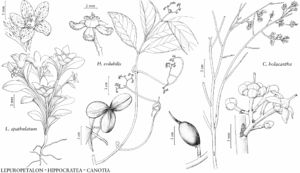Canotia
Rep. Colorado R. 4: 15. 1861.
| Taxon | Illustrator ⠉ | |
|---|---|---|
 | Hippocratea volubilis Canotia holacantha Lepuropetalon spathulatum |
Shrubs or trees. Branchlets terete. Leaves caducous scalelike, plants appearing leafless, alternate; stipules absent; petiole absent; blade margins entire; venation obscure. Inflorescences axillary, cymes or thyrses. Flowers bisexual, radially symmetric; perianth and androecium hypogynous; hypanthium absent; sepals 5, distinct; petals 5, greenish white to yellowish white; nectary absent; stamens 5; staminodes 0; pistil 5-carpellate; ovary superior, 5-locular, placentation axile; style 1; stigmas 5; ovules 2 per locule. Fruits capsules, 5-locular, oblong, apex beaked. Seeds 1–2 per locule, oval to oblong, winged in proximal 1/2; aril absent. x = 15.
Distribution
Arizona, n Mexico
Discussion
Species 2 (1 in the flora).
The systematic position of Canotia has been much disputed. Morphologic (M. C. Johnston 1975; H. Tobe and P. H. Raven 1993) and DNA-sequence data (M. P. Simmons et al. 2008) support placement in Celastraceae near Euonymus and Paxistima.
The other species of Canotia, C. wendtii M. C. Johnston, is restricted to Chihuahua, Mexico.
Selected References
None.